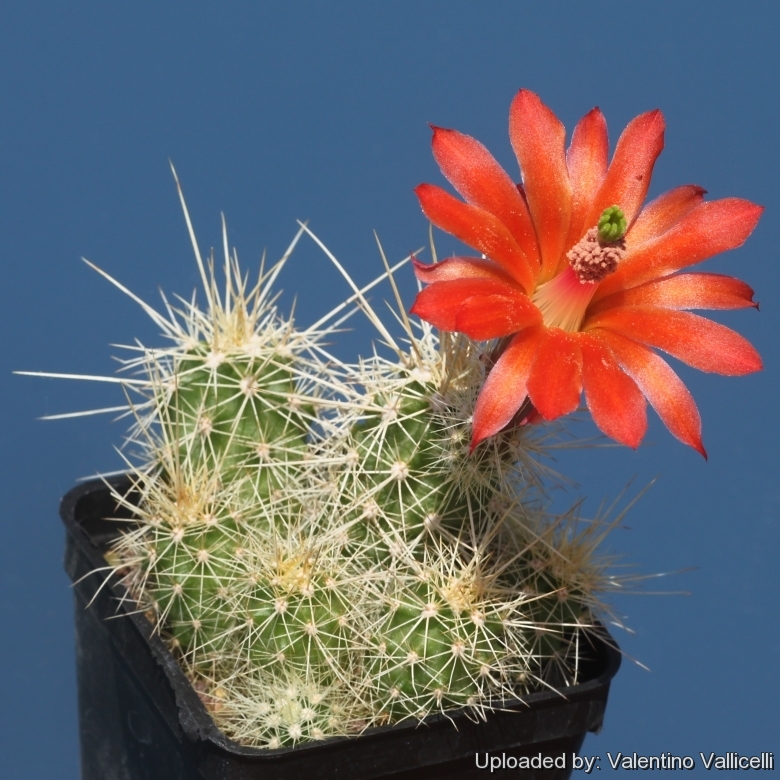
Echinocereus klapperi Photo by: Valentino Vallicelli
Origin and Habitat: Mexico Northwest (Sonora). It possible occurs south of the El Novillo dam. It has been found in Sierra de Mazatán in the state of Sonora, Mexico and it probably also occurs in adjacent Chihuahua.
Type Locality: El Novillo, Altitude 500 m.
Altitude: Between 300 and 500 metres above sea level.
Habitat and Ecology: This species has a very restricted range and is uncommon. It grows in wooded slopes in granitic, humus-filled cavities. In Sierra de Mazatán it occurs in oak woodland and gneiss.
Synonyms:
Description: This is a very spiny clustering plant that can grow more than 100 heads per clump with beautiful orange/red short tube flowers. It has a whitish appearance due to spine colour.
Roots: Fibrous.
Stems: Cylindrical, that branch profusely from the base, green 6-8 cm long and up to 3 cm in diameter.
Ribs: 9-10 flat.
Central spines: 3-4 protruding or outstretched 1-2,5 cm long, round in cross-section, creamy-white to yellowish turning grey with age.
Radial spines: 12 to 15, straight, acicular, 5-15 mm long, spreading out or add-pressed against the stem of the same colour of centrals.
Flower: Short tubular to funnel-shaped, 5 to 7 cm long and up to 5 cm in diameter, red with a lighter throat; stigma lobes green.
Fruit: Egg-shaped, 8-12 mm long, 9-11 mm in diameter, greenish-brown splitting open at maturity.
Bibliography: Major references and further lectures
1) Edward Anderson “The Cactus family” Timber Press, Incorporated, 2001
2) ames Cullen, Sabina G. Knees, H. Suzanne Cubey "The European Garden Flora Flowering Plants: A Manual for the Identification of Plants Cultivated in Europe, Both Out-of-Doors and Under Glass" Cambridge University Press, 11/Aug/2011
3) David R Hunt; Nigel P Taylor; Graham Charles; International Cactaceae Systematics Group. "The New Cactus Lexicon" dh books, 2006Albert Michael Powell, James F. Weedin “Cacti of the Trans-Pecos and Adjacent Areas” Texas Tech University Press, 2004
4) Baker, M., Van Devender, T. & Reina, A.L. 2013. Echinocereus klapperi. In: IUCN 2013. "IUCN Red List of Threatened Species." Version 2013.2. <www.iucnredlist.org>. 5) Urs Eggli, Leonard E. Newton "Etymological Dictionary of Succulent Plant Names" Springer, Berlin/Heidelberg 2010
6) W. Blum, M. Lange, W. Rischer, J. Rutow "Echinocereus" Preprint, 1998, S. [5].
 Echinocereus klapperi Photo by: Valentino Vallicelli
Echinocereus klapperi Photo by: Valentino Vallicelli Echinocereus klapperi Photo by: Carolina González
Echinocereus klapperi Photo by: Carolina González Echinocereus klapperi Photo by: Valentino Vallicelli
Echinocereus klapperi Photo by: Valentino Vallicelli Echinocereus klapperi Photo by: Valentino Vallicelli
Echinocereus klapperi Photo by: Valentino Vallicelli Echinocereus klapperi Photo by: Valentino Vallicelli
Echinocereus klapperi Photo by: Valentino Vallicelli Echinocereus klapperi Photo by: Valentino Vallicelli
Echinocereus klapperi Photo by: Valentino VallicelliCultivation and Propagation: In culture it is without problems, easy to grow, very attractive and regularly shows its beautiful flowers, if provided with an adequate winter rest period. It is sensitive to over-watering (rot prone), and needs good drainage. Keep drier and cool in winter. Needs full sun. In the summer they need an airy location in bright sun; well watered when it's hot. To achieve the best spine density give these plants lots of sun. In the winter light, cool, and absolutely dry conditions. In mild climate they grow well when planted freely outside in well-drained soil.
Propagation: Seeds (usually), it also can be grown from cuttings, as it can branch from the base.

















